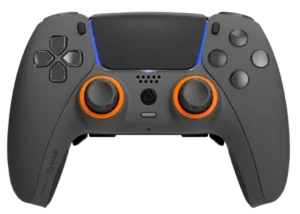The Hidden Dangers Lurking in Your Gaming Setup
In the world of high-stakes PC Gaming, every millisecond and every click counts. We invest heavily in our battlestations, meticulously selecting the best Gaming Hardware—from powerful Graphics Cards that render stunning worlds to high-refresh-rate Gaming Monitors that provide a buttery-smooth experience. At the heart of this interaction are our Gaming Peripherals: the tactile click of a mechanical Gaming Keyboard, the precise glide of a high-DPI Gaming Mouse, and the immersive audio from a 7.1 surround sound Gaming Headset. We trust these devices implicitly. They are our digital extensions, the conduits through which we conquer virtual worlds in FPS Games and command armies in Strategy Games. But what if that trust is misplaced? What if the very tools designed to give us a competitive edge become a gateway for malicious threats? The software that powers these advanced peripherals, often overlooked in our quest for performance, can represent a significant and underestimated cybersecurity vulnerability, turning a trusted ally into a digital Trojan horse.
Understanding the Attack Vector: How Peripherals Become a Threat
The physical hardware of a gaming mouse or keyboard is rarely the problem. The danger lies in the complex ecosystem of software required to unlock its full potential. Drivers, configuration utilities, and firmware updates are all necessary components that can be exploited by malicious actors. Understanding these entry points is the first step toward securing your Gaming PC.
The Software Supply Chain: A Chain of Trust
Modern Gaming Peripherals are more than just plug-and-play devices. To customize RGB lighting, program macros for MOBA Games like League of Legends or Dota 2, or fine-tune sensor settings for pinpoint accuracy in Valorant or Counter-Strike, you need to install companion software. This software creates a chain of trust: you trust the retailer you bought the device from, the manufacturer who made it, and the developers who wrote the software. A break anywhere in this chain can have disastrous consequences.
A primary threat is a compromised installer. A threat actor could create a convincing but fake website mimicking a popular peripheral brand, offering a “driver download” that is actually a malware-laden package. An even more insidious method is the supply chain attack, where attackers compromise the developer’s own systems. In this scenario, the malicious code is injected into the legitimate software *before* it’s officially released. The malware is then signed with the company’s legitimate digital certificate and hosted on their official website, making it nearly impossible for the average user to detect. When you download and install what you believe to be a safe utility for your new Gaming Mouse, you are unwittingly installing a backdoor into your system.
Firmware and Driver Vulnerabilities
Beyond the user-facing software, two other critical components can be targeted: drivers and firmware. Drivers are the low-level software that allows your operating system to communicate with the hardware. Unsigned or poorly written drivers can contain vulnerabilities that allow for privilege escalation, giving an attacker deep, kernel-level access to your PC. This is far more dangerous than a typical virus, as it can bypass many standard security measures.
Firmware is the permanent software programmed into the device itself. While less common, firmware-level attacks are incredibly potent. If an attacker can find a way to flash malicious firmware onto your keyboard or mouse, the device itself becomes the source of the infection. It could act as a keylogger, capturing every password you type, or execute commands automatically, all while remaining invisible to most antivirus software scanning the host PC. This level of threat is a major concern in the world of Competitive Gaming and Esports News, where hardware integrity is paramount.

Deconstructing the Threat: What Malicious Peripheral Software Can Do
Once malicious software gains a foothold on your system via a compromised peripheral installer, the potential for damage is immense. The goals of these attacks extend far beyond the realm of Video Games and can have severe real-world consequences for your digital life and financial security.
Data Theft and System Compromise
The most common objective of such malware is data theft. This can include:
- Credential Harvesting: Stealing login information for your Steam, Epic Games, or Battle.net accounts, which can be sold on the dark web. This also extends to bank accounts, email, and social media.
- Cryptocurrency Wallet Theft: Scanning the system for cryptocurrency wallet files and draining them of funds.
- Keylogging and Screen Capture: Recording everything you type and see, giving attackers access to sensitive private conversations, business documents, and financial information.
Beyond theft, the malware can grant an attacker complete control over your Gaming PC. It could be used to install ransomware, encrypting all your files and demanding a hefty payment. Your powerful gaming rig, with its high-end CPU and one of the latest Graphics Cards, could also be silently enrolled in a botnet, used to conduct DDoS attacks against websites or mine cryptocurrency for the attacker, degrading your system’s performance in demanding AAA Games.
A Case Study: The Hypothetical “Apex” Mouse Scenario
Imagine a popular new Gaming Mouse, the “Apex Predator,” is released, earning rave reviews for its sensor and ergonomics, making waves in Gaming News. To customize its features, users must download the “Apex Control” software. A cybercriminal group targets the manufacturer and successfully injects a small, obfuscated payload into the installer on the official download server. For weeks, thousands of gamers in the Gaming Community download and install this software. The installer works as expected, allowing users to configure their mouse for Apex Legends or Call of Duty. However, in the background, it also installs a remote access trojan (RAT). The attackers now have a backdoor into thousands of high-performance Gaming PCs. They wait patiently, then execute a coordinated attack, stealing Steam inventories, draining crypto wallets, and selling system access to other malicious groups. The fallout is immense, destroying the brand’s reputation and highlighting a critical blind spot in PC Gaming security.
Implications for the Gaming Industry and Community
The weaponization of Gaming Peripherals carries significant implications that ripple through the entire ecosystem, from individual players to the multi-billion dollar Gaming Industry itself. The trust between consumers and hardware manufacturers is a cornerstone of the market, and incidents involving malware can shatter that trust instantly.
Erosion of Brand Trust and Consumer Confidence
When a peripheral is found to be a vector for malware, the damage to the manufacturer’s brand is catastrophic. The Gaming Community is vocal and interconnected; news of such a breach, whether through Twitch News or social media, spreads like wildfire. Gamers will not only shun the affected product but may become wary of the brand’s entire product line, including their Gaming Chairs or Racing Wheels. This forces responsible companies to invest more heavily in cybersecurity audits, secure coding practices, and transparent communication with their user base, ultimately driving up the cost of Gaming Tech.

New Challenges for Esports and Competitive Gaming
In the high-stakes world of esports, hardware integrity is non-negotiable. A compromised mouse or keyboard could be used to inject subtle cheats that are difficult to detect by anti-cheat software. Imagine a firmware-level exploit that reduces recoil or automates complex actions in a MOBA or Battle Royale game. This undermines the very foundation of fair play in Competitive Gaming. Tournament organizers must now consider not only the software on the PCs but also the integrity of every single peripheral, from Game Controllers to Flight Sticks, potentially requiring certified, locked-down hardware for official events.
Fortifying Your Battlestation: A Gamer’s Guide to Peripheral Security
While the threat is real, succumbing to paranoia is not the answer. By adopting a security-conscious mindset and following a few best practices, you can significantly mitigate the risks associated with Gaming Peripherals and ensure your gaming rig remains a fortress.
Recommendations and Best Practices
1. Download from Official Sources Only: This is the single most important rule. Never download drivers or configuration software from third-party websites, forums, or links shared on social media. Always go directly to the manufacturer’s official website and ensure the connection is secure (look for HTTPS in the URL).

2. Verify Digital Signatures: Before running an installer, right-click the file, go to “Properties,” and look for a “Digital Signatures” tab. A legitimate installer from a reputable company will be signed with their certificate. If this tab is missing or the signature is invalid, do not run the file.
3. Use Robust Security Software: A comprehensive antivirus and anti-malware solution is not optional. Modern security suites are designed to detect suspicious behavior, such as an installer trying to make unauthorized changes to your system, and can often catch threats that signature-based detection might miss. Keep it updated at all times.
4. Be Wary of Unnecessary Software: Many peripherals work perfectly well with standard Windows drivers. If you don’t need to customize RGB or set up complex macros, consider forgoing the optional software suite altogether. This reduces your attack surface.
5. Stay Informed: Keep an eye on Gaming News and cybersecurity reports. If a vulnerability is discovered in a product you own, the manufacturer will likely issue a patch. Being aware allows you to take swift action to update your firmware or software and protect your system.
Conclusion: Play Hard, Play Smart
Our Gaming Peripherals are essential tools in our passion for Video Games, but like any powerful tool, they must be handled with care and awareness. The threat of malware being delivered through the software that powers our favorite Gaming Mice and Gaming Keyboards is no longer a theoretical concept; it is a demonstrated reality. The responsibility for security is a shared one. Manufacturers must prioritize secure development and transparently address vulnerabilities, while we, the Gaming Community, must remain vigilant. By sourcing our software carefully, scrutinizing what we install, and employing robust security measures, we can continue to enjoy the competitive edge our hardware provides without exposing our digital lives to unnecessary risk. In the end, the smartest gamer is not just the one with the fastest reflexes, but the one with the most secure setup.













